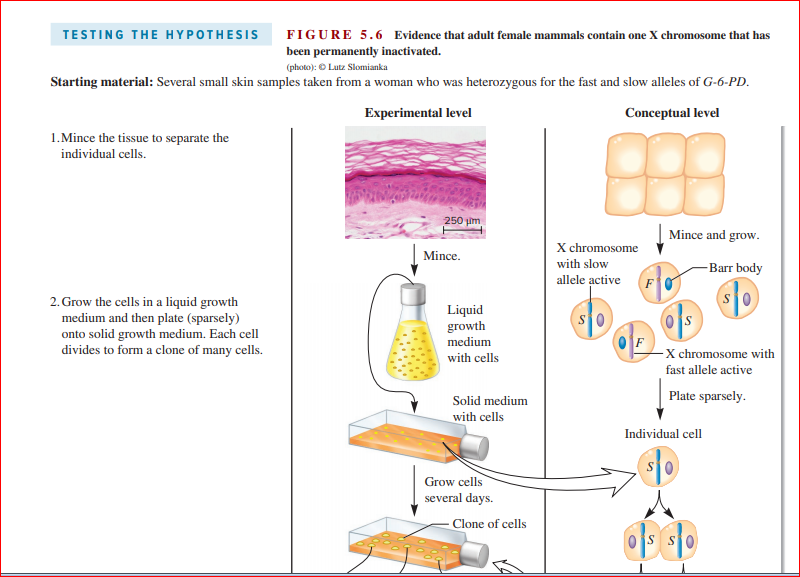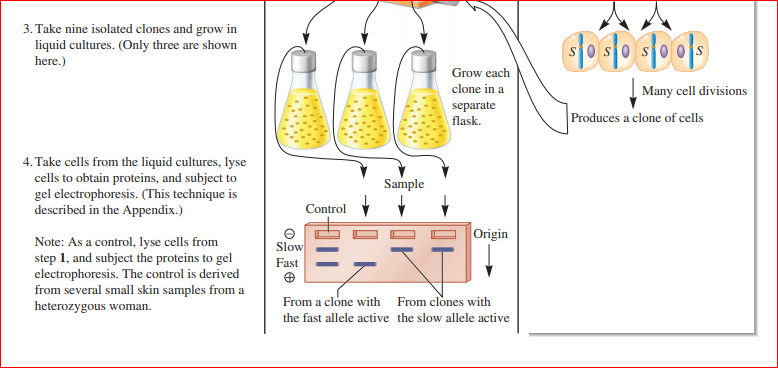FIGURE 5.6 Evidence that adult female mammals contain one X chromosome that has been permanently inactivated. TESTING THE HYPOTHESIS (photo): © Lutz Slomianka Starting material: Several small skin samples taken from a woman who was heterozygous for the fast and slow alleles of G-6-PD. Experimental level Conceptual level 1.Mince the tissue to separate the individual cells. 250 im Mince and grow. X chromosome Mince. with slow -Barr body allele active 2. Grow the cells in a liquid growth medium and then plate (sparsely) onto solid growth medium. Each cell divides to form a clone of many cells. Liquid growth medium with cells -X chromosome with fast allele active Solid medium Plate sparsely. with cells Individual cell Grow cells several days. Clone of cells 3. Take nine isolated clones and grow in liquid cultures. (Only three are shown sOsOsO 0S here.) Grow each | Many cell divisions Produces a clone of cells clone in a separate flask. 4. Take cells from the liquid cultures, lyse cells to obtain proteins, and subject to gel electrophoresis. (This technique is described in the Appendix.) Sample Control Origin Note: As a control, lyse cells from step 1, and subject the proteins to gel electrophoresis. The control is derived from several small skin samples from a heterozygous woman. Slow Fast From a clone with From clones with the fast allele active the slow allele active
Molecular Techniques
Molecular techniques are methods employed in molecular biology, genetics, biochemistry, and biophysics to manipulate and analyze nucleic acids (deoxyribonucleic acid (DNA) and ribonucleic acid (RNA)), protein, and lipids. Techniques in molecular biology are employed to investigate the molecular basis for biological activity. These techniques are used to analyze cellular properties, structures, and chemical reactions, with a focus on how certain molecules regulate cellular reactions and growth.
DNA Fingerprinting and Gel Electrophoresis
The genetic makeup of living organisms is shown by a technique known as DNA fingerprinting. The difference is the satellite region of DNA is shown by this process. Alex Jeffreys has invented the process of DNA fingerprinting in 1985. Any biological samples such as blood, hair, saliva, semen can be used for DNA fingerprinting. DNA fingerprinting is also known as DNA profiling or molecular fingerprinting.
Molecular Markers
A known DNA sequence or gene sequence is present on a chromosome, and it is associated with a specific trait or character. It is mainly used as a genetic marker of the molecular marker. The first genetic map was done in a fruit fly, using genes as the first marker. In two categories, molecular markers are classified, classical marker and a DNA marker. A molecular marker is also known as a genetic marker.
DNA Sequencing
The most important feature of DNA (deoxyribonucleic acid) molecules are nucleotide sequences and the identification of genes and their activities. This the reason why scientists have been working to determine the sequences of pieces of DNA covered under the genomic field. The primary objective of the Human Genome Project was to determine the nucleotide sequence of the entire human nuclear genome. DNA sequencing selectively eliminates the introns leading to only exome sequencing that allows proteins coding.
why does a clone of cells produce
only one type of G-6-PD enzyme? What would you expect to happen if a clone was derived from an early embryonic cell? Why
does the initial sample of tissue produce both forms of G-6-PD?


Trending now
This is a popular solution!
Step by step
Solved in 2 steps




